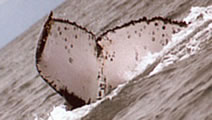
A humpback whale travelled 6,200 miles from the coast of Brazil to Madagascar, more than twice as far as humpbacks usually manage on a single migration - setting the new world record for the Longest recordeed migration of any mammal.
It remains a mystery why a female humpback whale swam thousands of miles from the reefs of Brazil to the African island of Madagascar, which researchers believe is the longest single trip ever undertaken by a mammal — humans excluded.
While humpbacks normally migrate along a north-to-south axis to feed and mate, this one — affectionately called AHWC No. 1363 — made the unusual decision to check out a new continent thousands of miles to the east.
Marine ecologist Peter Stevick says it probably wasn't love that motivated her — whales meet their partners at breeding sites, so it's unlikely that this one was following a potential mate. "It may be that this is an extreme example of exploration," he said. "Or it could be that the animal got very lost."
Stevick laid out the details of the whale's trip on Wednesday in the Royal Society's Biology Letters, calculating that, at a minimum, the whale must have traveled about 6,200 miles (10,000 kilometers) to get from Brazil to Madagascar, off the coast of east Africa.
"No other mammal has been seen to move between two places that are further apart," said Stevick, who works at the Maine-based College of the Atlantic. And while he said "the distance alone would make it exceptional no matter where it had gone," there was an added element of interest.
It was by browsing photo-sharing site Flickr that one of Stevick's colleagues found a photo of this particular humpback, taken by a Norwegian tourist from a whale-watching vessel off the coast of Madagascar in 2001.
The photo had been taken with a film camera and the negative sat undeveloped in a drawer for years. Eventually, it was scanned and posted to the Web, where it was spotted and added to the catalogue.
Stevick's colleagues matched the Flickr photo to a picture of the whale taken two years earlier in Abrolhos, an area of small volcanic islands off the Brazilian coast.

Photo: This 2001 taken in Madagascar shows a female humpback whale's tail fin, commonly known as a "fluke." This photo was used to identify a whale that traveled 6,200 miles from Brazil to Africa. / Photo: F. Johansen/AP
Carole Carlson, Stevick's colleague, said the key to identifying humpback whales is in their tails. Humpbacks have big tail fins called "flukes," which are spotted and ridged.
Carlson compared them to "huge fingerprints." Stevick elaborated: "There's an enormous amount of information in those natural markings. There's the basic underlying pattern of the black and white pigment on it, numerous scars across the tail, and the edge is very jagged — each of those things provides a piece of information."
Humpbacks are careful commuters, taking the same trip from cold waters where they hunt plankton, fish and krill to warm waters where they mingle and mate "year after year after year," he said. The location of their feeding and breeding spots sometimes varies, but their transoceanic commute doesn't usually change much.
Humpback whales are powerful swimmers, and the 40-ton (36-metric ton) behemoths typically clock up 5,000 miles in their trips from the frosty waters of the North Atlantic and the Antarctic to more temperate areas around the equator.
They're known for their eerie songs — composed of moans and cries — which travel huge distances underwater and whose precise function remains a mystery. They're also cherished by whale-watchers for their spectacular out-of-the-water jumps, called breaching.
As to why the whale went the way it did, Simon Ingram, a professor of marine conservation at the University of Plymouth in southern England, said that, "the fact is, we just don't know. "You can track them, but you don't know what's motivating them."
Guinness World Records recognize the blue whale as the largest mammal on earth.
The Guinness World Record for the largest mouth world belongs to the Bowhead whale (Balaena mysticetus) and can measure 5 m (16 ft) long, 4 m (12 ft) high and 2.5 m (8 ft) wide. Its tongue weighs approximately one ton (900 kg).
0 comments:
Post a Comment